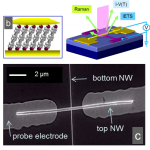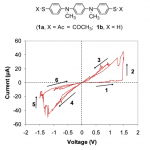 “Crossed-nanowire molecular junctions: A new multi-spectroscopy platform for molecular conduction-structure correlations”, H. P. Yoon, M. M. Maitani, O. M. Cabarcos, L. Cai, T. S. Mayer, and D. L. Allara, Nano Letters 10 (8), 2897-2902, 2010.
“Crossed-nanowire molecular junctions: A new multi-spectroscopy platform for molecular conduction-structure correlations”, H. P. Yoon, M. M. Maitani, O. M. Cabarcos, L. Cai, T. S. Mayer, and D. L. Allara, Nano Letters 10 (8), 2897-2902, 2010.
1. Department of Electrical Engineering, 2. Department of Materials Science and Engineering, and 3.Department of Chemistry, The Pennsylvania State University, University Park, Pennsylvania 16802
ABSTRACT. We report a crossed-nanowire molecular junction array platform that enables direct measurement of current-voltage-temperature characteristics simultaneously with inelastic electron tunneling and Raman vibrational spectra on the same junction. Measurements on dithiol-terminated oligo(phenylene-ethynylene) junctions show both spectroscopies interrogate the gap-confined molecules to reveal distinct molecular features. This versatile platform allows investigation of advanced phenomena such as molecular switching and cooperative effects with the flexible ability to scale both the junction geometries and array sizes.


